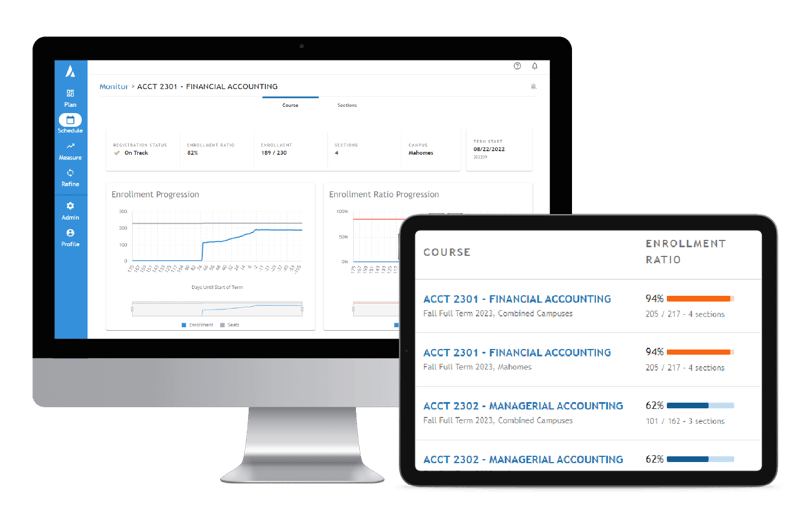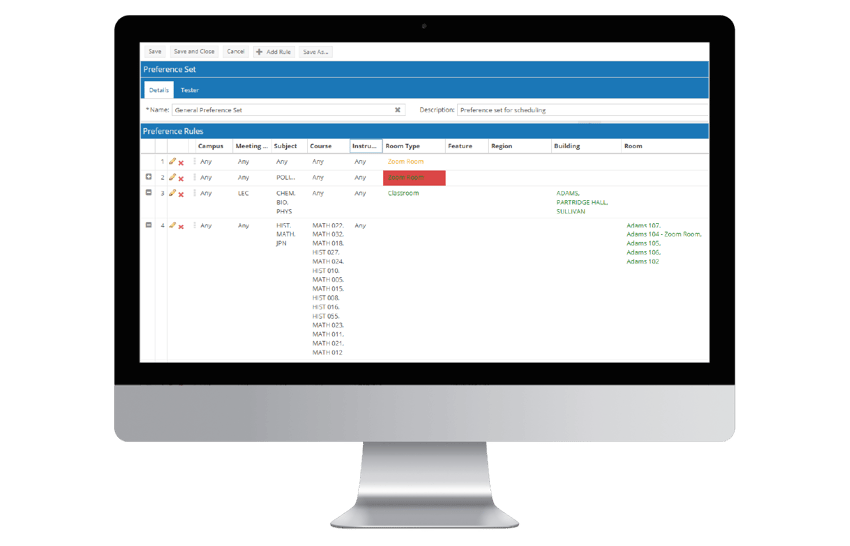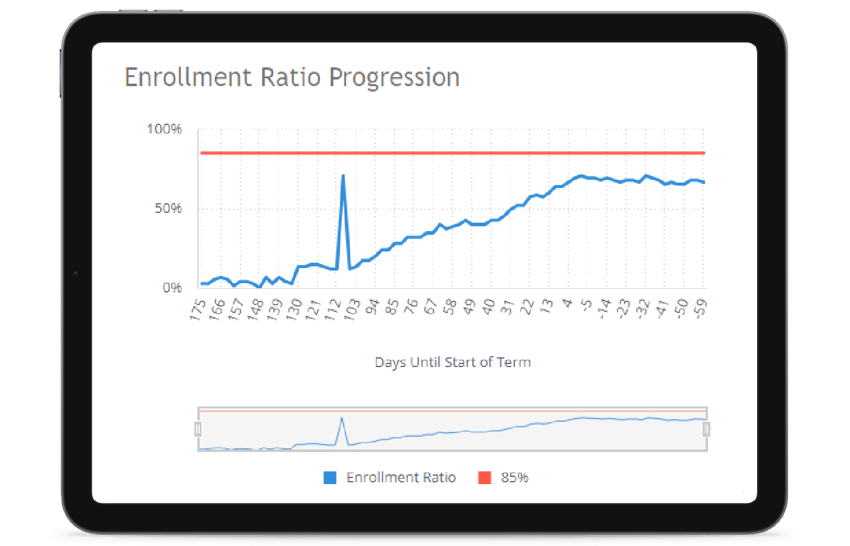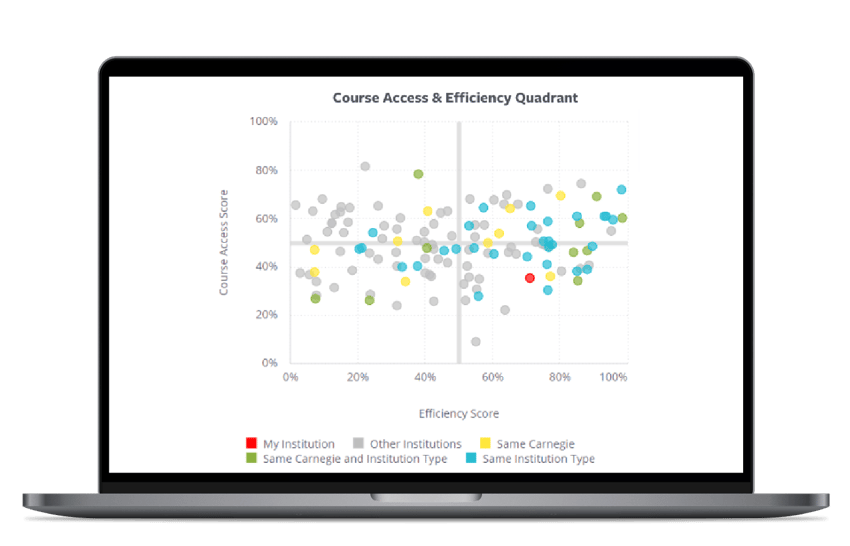DATA-INFORMED ACADEMIC SCHEDULING
Optimize course schedules with embedded intelligence.
Empower your institution to operate as a center of excellence with data-informed strategies. Confidently analyze data to improve schedule effectiveness, optimize faculty scheduling, and adapt to real-time enrollment fluctuations.

Smart systems that allow you to refine and intervene with confidence.
Agile Decision-Making
Proactively refine class schedules and minimize disruptions due to last-minute changes with real-time data from advanced scheduling software.
Classroom Optimization Tools
Maximize space utilization with smart course scheduling systems informed by custom preferences and 'what-if' scenarios.
Academic Workload Planning
Manage instructor assignments, prevent overloading, and gain insights into both instructional and non-instructional workloads with faculty scheduling insights.
Contextual Awareness
Leverage the industry’s only benchmarking database to evaluate your scheduling efforts against your peers. Use this data to enhance completion rates, optimize faculty capacity, and increase operational efficiency.

CLASSROOM OPTIMIZATION
Maximize your spaces with optimized room assignments.
Model what-if scenarios with a room scheduling system that efficiently assign spaces using state-of-the-art algorithms and custom class scheduling preferences.
Save time with quick space allocation
Automatically find available spaces with an intelligent room scheduling system, eliminating the need for manual room searches.
Optimize existing room utilization
Use smart classroom optimization and room criteria to identify spaces that align with class needs.
Draft multiple scenarios
Experiment with data-driven scheduling scenarios, preview changes, and adjust room assignments with confidence before setting them live.

COURSE REGISTRATION MONITORING
Monitor registrations and proactively respond to student needs in real time.
Refine and adapt your schedule with real-time registration visibility. Adjust your academic schedule with data-informed course insights, and stay prepared for shifting student demand with notifications for courses nearing capacity or requiring additional enrollments.
Get ahead of late cancellations
Monitor course enrollment trends to adjust offerings during registration. Leverage data-informed insights to optimize resource allocation and minimize waste on unneeded sections.
Foster departmental coordination
Use academic scheduling software to collaborate with stakeholders on change requests and confirmations efficiently.
Enhance decision efficiency
Simplify enrollment reports with data-driven scheduling software, offering clear visualizations into fill rates to keep you confident during the registration cycle.
Identify modality preferences
Understand how the blend of modalities your institution offers affects student enrollment trends and preferences in real-time.
Reduce late adds and cancellations
Minimize disruptions to student progress and faculty assignments by identifying bottlenecks and inefficiencies using course registration analytics.

HESI® REPORTS
Leverage peer-to-peer course schedule benchmarking.
Using Ad Astra’s Higher Education Scheduling Index (HESI®), see how effective your course scheduling practices are versus your peers. Leverage data to improve Degree Velocity®, on-time graduation rates, faculty scheduling, and operational efficiency.
Benchmark outcomes against like institutions
Understand how your institution stacks up across 20+ key academic course scheduling and space capacity measures with peer institutions via our benchmark database.
Improve schedule efficiency
Minimize conflicts for students and reduce off-grid waste by monitoring meeting pattern usage with Ad Astra's data-informed scheduling analytics.
Meet student demand while optimizing resources
Create a balanced schedule by identifying underutilized and overloaded courses in your institution's schedule.
Make classes more accessible
Identify peak hours of student demand and analyze with student demographics to develop a more equitable and accessible schedule.
We're powering progress through Smart Scheduling™.
Learn how using real-time data and thoughtful design
produces high-quality, student-centered schedules.
Learn how using real-time data and thoughtful design
produces high-quality, student-centered schedules.
Success Stories
550+ institutions. 4.5 million students. And counting.
Learn how institutions just like yours are achieving their outcomes with data-informed scheduling and planning solutions.


10.0% growth in fall-over-fall enrollments and 997 seats added
See how Bossier Parish Community College was able to identify bottlenecks and monitor registration in real time to support growth.


8.6% increase in Latino student retention rates
Using data-informed scheduling systems to identify course roadblocks, Texas A&M discovered new ways to decrease stop-outs and improve student success.

.png?width=578&height=165&name=logo-NLC%20(1).png)
14% year-over-year contact hour increase
Discover how Northeast Lakeview College achieved sustained growth through academic scheduling software that optimizes their course offerings.


Streamlined registration process across 7 campuses
Discover how Collin College improved its registration process across seven campuses by replacing outdated spreadsheets with data-informed software that provides reliable data and dynamic visuals.


29% growth in completion among the three largest minority groups
By disaggregating academic scheduling statistics for minority and Pell-eligible students, Montgomery College is accelerating student completion rates.
Integrations












